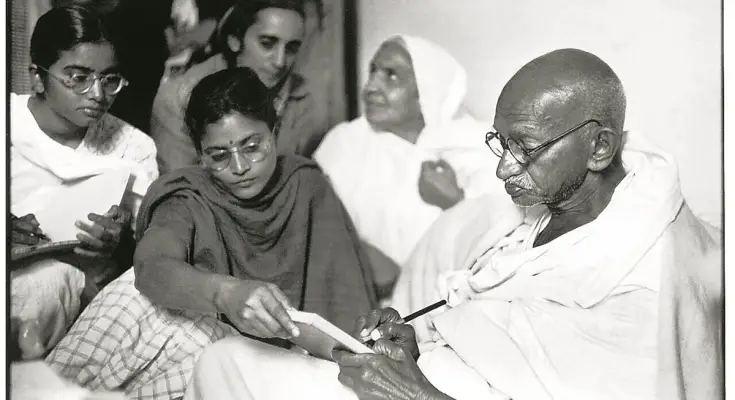
Henri Cartier-Bresson’s exhibition in New York City offers a ringside view of key political and everyday events of mid-20th century India, besides some rare glimpses of Mahatma Gandhi’s final day
 |
| Muslim refugee train from Delhi to Lahore, Pakistan, passing through Kuinkshaha station, Kuinkshaha, North India, India, 1947 ©Henri Cartier-Bresson/Magnum Photos |
The five floors of Rubin Museum in New York City’s bustling Chelsea neighbourhood are teeming with people even on a weekday afternoon. As you enter the elevator, instead of the respective floors, the buttons are marked by the exhibits that one is looking to visit — “The World is Sound”, “Sacred Spaces”, “Masterworks of Himalayan Art” or “India in Full Frame”, the India-centric exhibition by master photographer Henri Cartier-Bresson. Even though the exhibits traverse Asia’s diverse cultures, regions and narratives, one is surprised to notice most people looking to visit the India exhibit.
Or not so surprised actually. As its curator, Beth Citron, puts it: “The exhibition shows many of Cartier-Bresson’s most iconic and important photos from India, which have not been shown together in the US before.” Citron adds that the 69 photos on display in the exhibition were selected by Cartier-Bresson himself, so the intended audience was not specifically American.
“India in Full Frame” offers the French photographer’s perspective on India during the mid-20th century. It was an extremely important moment in the history of India as Cartier-Bresson made his first visit to the country just a few months after Independence. The first photograph on display is a candid shot of then Prime Minister Jawaharlal Nehru and Edwina Mountbatten sharing a light moment. There are also pictures of other key political leaders of the time, from Mahatma Gandhi to Sardar Patel, as well as shots of the erstwhile royalty.
 |
| Gandhi dictates a message, just after breaking his fast, Birla House, Delhi, India, 1948 Photos: ©Henri Cartier-Bresson/Magnum Photos |
This is followed by a plethora of extraordinary shots curated from the everyday life of Nehruvian India — an astrologer’s shop in the mill workers’ quarter of Mumbai’s Parel, shots from the old town of Ahmedabad, havelis of Old Delhi, women queuing up outside a mosque in Srinagar, or even farm workers in Tamil Nadu. In fact, Cartier-Bresson’s unique style of “street photography”, which has influenced generations of photographers, was developed during his travels around the world.
His marriage to Javanese dancer Ratna Mohini also propelled his interest in classical dance forms. He visited some dance schools in south India and captured brilliant shots of youngsters undergoing gruelling Kathakali training sessions from their gurus.
Cartier-Bresson’s works offer great insight into India of the time. Disputed borders, refugees, charismatic leaders, assassinations — the India of the mid-20th century does not sound so distant from the world today. Both the time as well as the place have been captured expertly by the “humanist” photographer. Besides the 69 photographs, there are also his letters, camera and other personal ephemera on display. The showcase coincides with the 70th anniversary of Magnum Photos, the cooperative agency co-founded by Cartier-Bresson.
After travelling the length and breadth of India in December 1947, Cartier-Bresson came back to Delhi in January 1948 to meet with one of the key players in India’s political transition, Mahatma Gandhi. Little did anyone know that it would be one of Gandhi’s final meetings before his assassination on January 30. The resulting images of Gandhi’s last day of life and the events surrounding his funeral are part of a selection. A key set of photographs on view show Gandhi’s final hours, and events following his assassination, which helped catapult Cartier-Bresson to international fame. A remarkable photo in the lot is of Nehru’s reaction in the aftermath of his demise — without his signature cap, his mouth wide open and his eyes looking haplessly towards the skies.
Citron, who curates Modern and Contemporary Art at the Rubin, says, “The images reflect Cartier-Bresson’s mastery of his medium, as well as his abiding interest in the people and sites of India.” She adds that the exhibition, in the works for two years, came about in celebration of Magnum Photo’s 70th anniversary, which also coincides with the 70th anniversary of India’s independence and Partition. The photos have been shown previously at the Noble Peace Center in Oslo in 2012, and the exhibition is on till September 4.
Cartier-Bresson, who died in 2004 at the age of 95, studied painting in the 1920s and made a serious commitment to photography in the early 1930s. In the early 1940s, he spent three years in prisoner-of-war camps before he escaped and joined the Paris underground, filming the homecoming of French POWs. In 1947, he founded Magnum along with Robert Capa, David Seymour and others. His work took him all over the world — to India, Burma, Pakistan, China and Indonesia, among others. Over the course of his career, Cartier-Bresson published his photographs in prestigious magazines and photo books, and held exhibitions across the world.
Written by Divya A | Published:June 30, 2017 12:41 am

